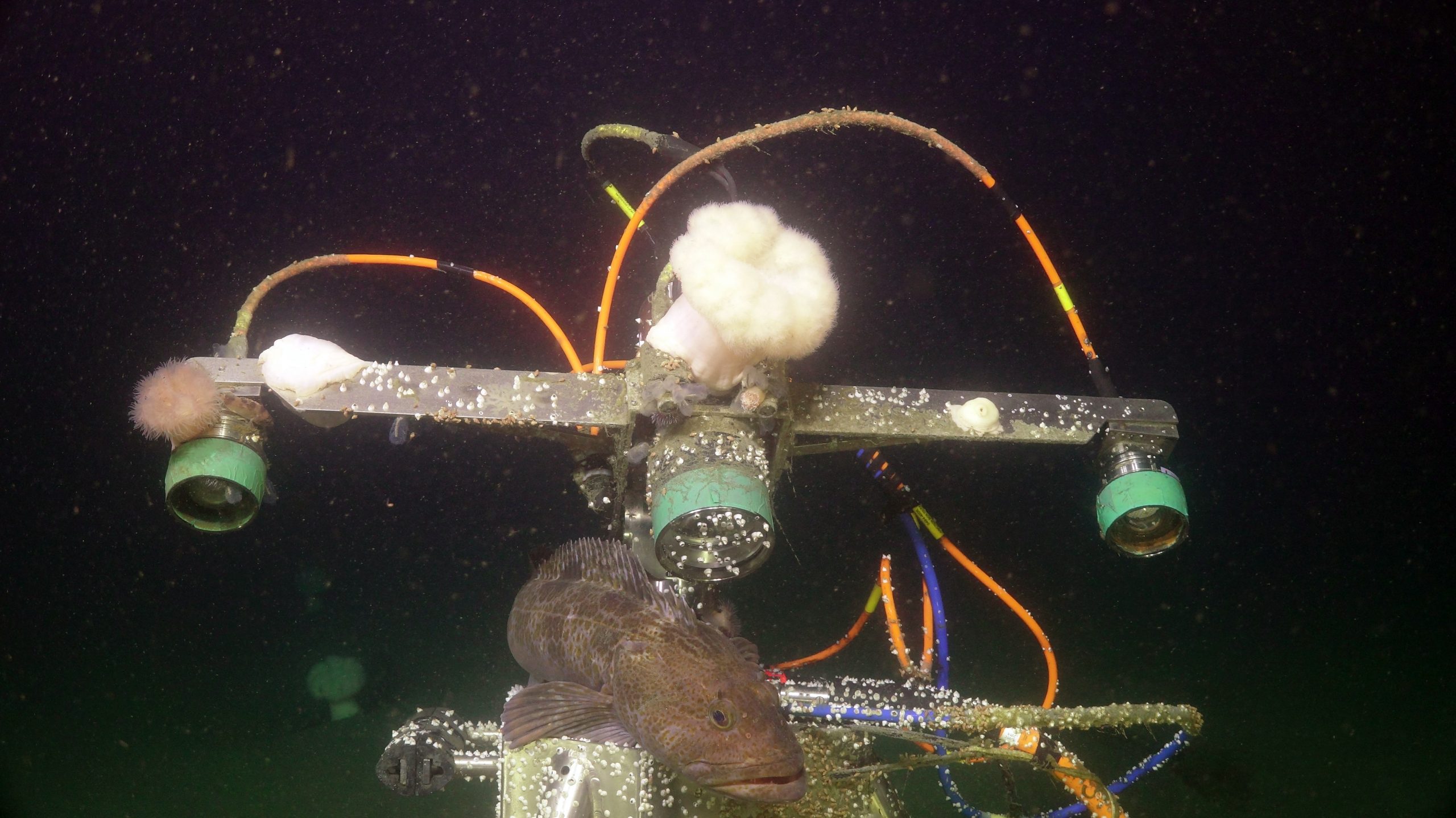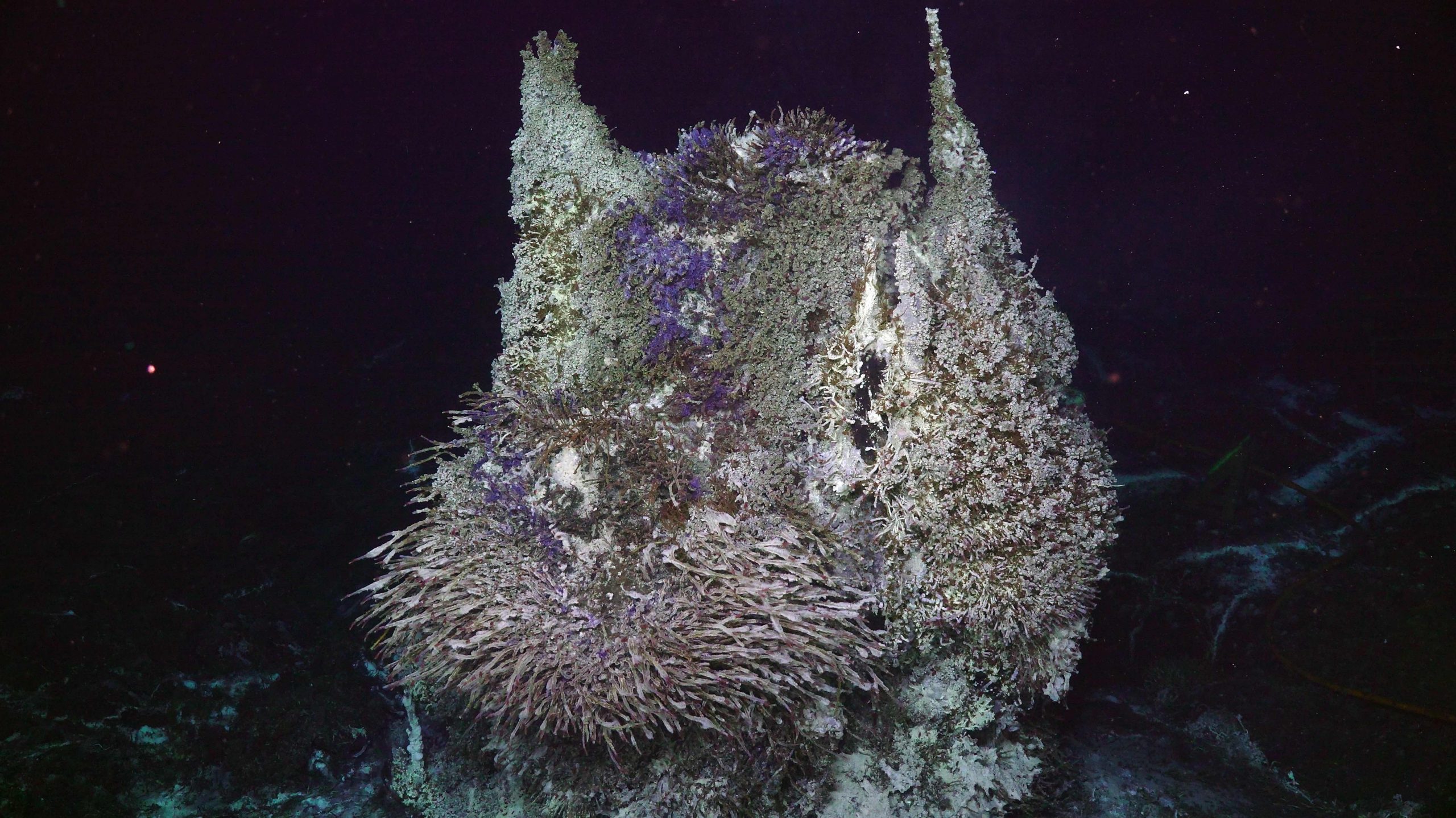Image Archive





























The fantail of the R/V Thompson is loaded with BEP's. junction boxes, and a sonar on Leg 2 of VISIONS20. Credit: M. Elend, University of Washington. V20

Jason moves into position to clean the Deep Profiler cable at Slope Base. The instrumented DP vehicle is in the background. Credit: UW/NSF-OOI/WHOI; V20.

The medium powered junction box MJ03E is moved into position for latching into with Jason. Credit: UW/NSF-OOI/WHOI:V20.

The medium powered junction box at the Eastern Caldera site sits atop lobate flows at Axial Seamount. Credit: UW/NSF-OOI/WHOI.V20

A spider crab explores a small collapse pit floored by glass lava talus on the summit of Axial Seamount. Credit: UW/NSF-OOI/WHOI: V20.

A spider crab delicately walks across glassy rubble in a small collapse pit. Credit: UW/NSF-OOI/WHOI: V20.

A spider crab hangs upside down exiting a glassy collapse zone. Credit: UW/NSF-OOI/WHOI: V20.

A cod brushes against the digital still camera at the Oregon Shelf site (80 m). Credit: UW/NSF-OOI/WHOI. V20.

If you look closely within the Benthic Experiment Platform, you will see a lingcod eyeing you. Credit: UW/NSF-OOI/WHOI. V20.

A lingcod brushes against the digital still camera at the Oregon Shelf site (80 m). The camera is covered in anemones and barnacles. Credit: UW/NSF-OOI/WHOI. V20.

A lingcod rests on the side of the digital still camera at the Oregon Shelf site (80 m). Credit: UW/NSF-OOI/WHOI.V20

Chief Scientist, Orest Kawka, and Co-Chief Scientist, Brendan Philip, discuss cruise operations during Leg 2 of VISIONS'20. Credit: M. Elend, University of Washington.

The MJ03E junction box is moved into position for deployment with the ROV Jason at the Eastern Caldera Site. Credit: UW/NSF-OOI/WHOI. V20

The MJ03E junction box is recovered latched beneath Jason after being on the seafloor 2583 days..and still fully functional. Credit. M. Elend, University of Washington.

A new junction box awaits final connection at the Eastern Caldera site. Credit: UW/NSF-OOI/WHOI. V20

The fantail of the R/V Thompson is fully loaded at the start of Leg 2. A zooplankton platform is moved into place for subsequent latching into by Jason for installation at the Oregon Shelf site. Credit. M. Elend, University of Washington. V20.

The titan4 arm of Jason reaches for the osmotic fluid sampler in the ASHES hydrothermal field. Fractures in the lobate lava flows leaking warm fluids support colonies of whte bacteria and small tube worms. The HD video camera is in the background. Credit: UW/NSF-OOI/WHOI. V20

A sablefish lounges on the zooplankton sonar platform at the Oregon Shelf site (80 m). Credit: UW/NSF-OOI/WHOI. V20.

A brush is used to clear away anemones that are hiding access to the junction box at the Oregon Shelf site. Credit: UW/NSF-OOI/WHOI; V20

The MJ01C junction box at the Oregon Shelf site is completely encased in anemones. Credit: UW/NSF-OOI/WHOI; V20.

Chief Scientist Brendan Philips oversees work on the fantail of the R/V Thompson as the ship prepares to sail again to complete Regional Cabled Array work for 2020. Credit. J. Tilley, University of Washington. V20

A wall of monitors inside the Jason control van provide a wealth of information to Jason and the RCA Science-Engineering team. Here, the ROV is installing a sensor into the high temperature vent 'Diva.' Credit: University of Washington. V20.

Chief Scientist B. Philip and engineer I. Borchert process water samples from the Slope Base site. Credit: University of Washington. V20.

The R/V Thompson heads under Yaquinna bridge at the end of Leg 1. Credit: University of Washington. V20.

A NSF-funded CTD is reinstalled in the ASHES vent field as part of an award to Dr. Bill Chadwick (OSU). Credit: UW/NSF-OOI/OSU/WHOI. V20.

The summit of the active hydrothermal chimney is covered in a dense community of tubeworms, palm and scale worms, blue ciliates and white filamentous bacteria. Credit: UW/NSF-OOI/WHOI.V20

The cabled high definition camera reinstalled at the base of the Mushroom vent during VISIONS'20. Credit: UW/NSF-OOI/WHOI.20.

Small chimlets sprout from the top of Mushroom, covered in blue ciliates, palm and tubeworms and limpets. Credit: UW/NSF-OOI/WHOI. V20.
- Anemone
- Animal
- Arthropod
- ASHES
- Axial
- Axial Base
- Axial Biology
- Axial Caldera
- Bacteria
- Basalt Lava
- BEP
- Biofouling
- biolgoy
- Biology
- Camds
- Camera
- Camhd
- Central Caldera
- Ciliates
- Cnidaria
- Coastal Biology
- Crab
- Deep Profiler Mooring
- Dive Highlights
- Eastern Caldera
- Echinoderms
- Endurance Array
- Engineering Team
- ENLIGHTEN 10
- Exploratorium
- Fish
- Geology
- HD Camera
- HPIES
- Hydrate Ridge
- Hydrates
- Hydrophone
- Hydrothermal Vents
- Illustration
- Inshore 80 Meters
- Instrument
- International District
- J-BOX
- Jason
- Jellyfish
- Junction Box
- K12
- Lava
- Mollusk
- Moorings
- Nodes
- Nudibranch
- Octopus
- OOI
- Oregon Offshore
- Oregon Offshore 600 m
- Oregon Shelf
- Oregon Slope Base
- People
- PN1B
- PN1D
- Polychaetes
- PPSDN
- Primary Node
- RASFL
- ROCLS
- ROPOS
- ROPOS Dives
- ROV Team
- RV Revelle
- RV Sikuliaq
- RV Thompson
- Salp
- Sample
- SC13
- Science Team
- Sea Cucumber
- Sea Star
- Sea Urchin
- Seafloor
- Seismometer
- Sensors
- Shallow Profiler Mooring
- Shark
- Shipboard
- Shore Station
- Slope Base
- Smoker
- Soft Coral
- Southern Hydrate Ridge
- Sponge
- Squid
- Students
- Students & Guest Participants
- Tmpsf
- Tubeworms
- VISIONS 11 Leg 1
- VISIONS 11 Leg 2
- VISIONS 11 Viewers
- VISIONS 13
- VISIONS 14
- VISIONS 15
- VISIONS 16
- VISIONS 17
- VISIONS 18
- VISIONS 20
- VISIONS 22
- VISIONS 23
- Visualization
